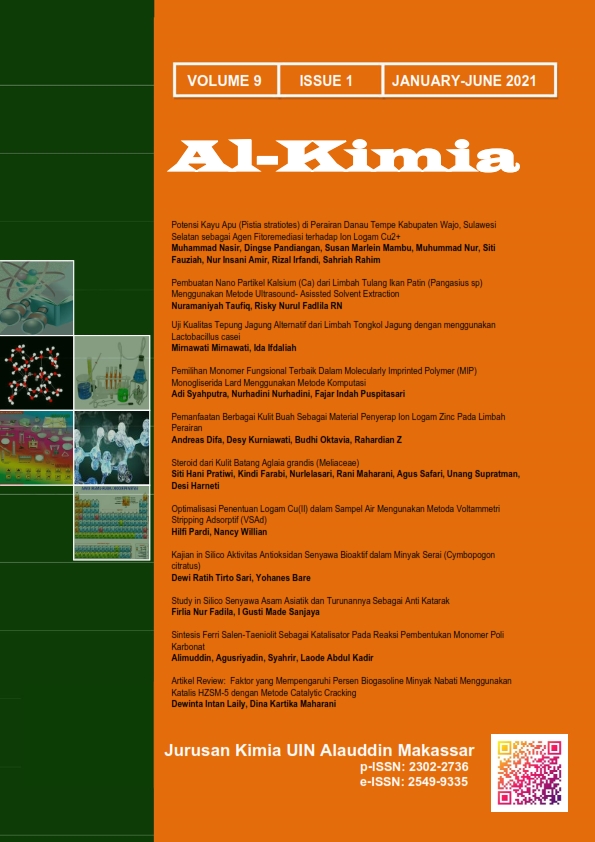Uji Kualitas Tepung Jagung Alternatif dari Limbah Tongkol Jagung Menggunakan Lactobacillus casei
Abstract
Corn cobs are agricultural waste that is very widely available and has the potential to be developed as corn flour. This modified corn flour from corn cobs waste can be an alternative to flour in several flour-based processed products. The use of corn cobs, which so far has less economic value, is to conduct research to determine the quality content of corn flour and corn cobs, so it is necessary to characterize the quality of corn, especially microbial contamination based on the SNI standards that have been set.Methods: water content using gravimetric method, ash content using gravimetric method, microbial contamination test using ALT method of 25-250 colonies / gram counted and analysis of mold and E. coli bacteria. The results showed that the ash content was 0.0433%, 13.57% moisture content, 11.91% protein content, ALT 1.8 x 106, mold analysis of 4.3 x 102 cology / gram and analysis of E. coli bacteria amounting to 7.1 APM / g and B. subtilis amouting <1,0 x 102coloni/g. So it can be concluded that corn cobs waste can be used as corn flour because it has fulfilled the SNI
Downloads
References
Aini, N., Wijanarko, G., Sutriawan, B. (2016). Sifat Fisika, Kimia dan Fungsinal Tepung Jagung yang diproses Melalui Fermentasi. Jurnal Agritech.36(2).
Augustia, G. (2019). Analisis Fisikokimia Beberapa Jenis Tepung Jagung Asal Pulau Mmoa Kabupaten Maluku Barat Daya. Jurnal Agritekno Teknologi Pertanian. 8(2) : 58-63
Azwar, A. (2016). Pemanfaatan limbah tongkol jagung (zea mays L) sebagai arang aktif dalaam menurunkan kadar amonia, nitrit dan nitrat pada limbah cait industri tahu menggunakan teknik celup. Jurnal Kimia Mulawarman. 13(2) .
Fafa. (2017). Evaluasi pertumbuhan lactobacillus casei dalam medium pertumbuhan yang disubstitusi tepung kulit pisang kepok. Seminar Nasional Pengabdian Masyarakat.
Faesal. (2013). Pengolahan Limbah Tanaman Jagung Untuk Pakan Ternak Sapi Potong. Seminar Nasional Inovasi Teknologi Pertanian.Balai Penelitian Tanaman Serealia.
Ganzle, M.G. (2008). Proteolysis in sourdoungh fermentations: mechanisms and potential for improved bread quality. Trends in Food Science and Technology, 19: 513-521.
Gerez, L.C. (2006). Gluten breakdown by lactobacilli andpediococi strains isolated from sourdough. Letters in Applied Microbiology, 42(5):459-464.
Khasanah. (2014). Pengaruh lama Fermentasi dan Penambahan Bakteri Asam Laktat terhadap mutu tape singkong. UNESA Journal of Chemistry. 3(1).
Kriskenda. Y, D. Heriyadi dan I. Hernaman. (2016). Pengaruh Perendaman Tongkol Jagung dengan Berbgaai Konsentrasi Filtrat Abu Sekam Padi Terhadap Kadar lignin dan Serat Kasar. Majalah Ilmiah Peternakan. 9(1).
Peraturan Menteri Perindustrian No59/M-IND/PER/7/2015. SNI 3751-2009. Tepung Terigu Sebagai Bahan Makanan. Badan Standar Nasional.
Peraturan Menteri Perindustrian No59/M-IND/PER/7/2015. SNI 7388-2009-1.Batasan Maksimum Cemaran Mikroba dalam Pangan. Badan Standar Nasional.
Ratna. (2014). Kajian Pembuatan Tepung Jagung dengan Proses Pengolahan yang berbeda. Seminar Nasional Teknologi Pertanian Balai Pengkajian Teknologi Pertanian (BPTP) Lampung.
Reza, S. (2011). Evaluasi Pemanfaatan Pakan dengan dosis Tepung Jagung Hasil Fermentasi yang berbeda untuk Pertumbuhan Benih Ikan Mas. Jurnal Riset Akuakultur. 6(2) .
Rohmiyatul. (2014). Kandungan protein dan serat kasar tongkol jagung yang diinokulasi Trichoderma sp. Pada lama inkubasi berbeda. Jurnal Kimia Unhas.
Sandhu. (2007). Some properties of corn grains and their flours I: physico-chemical, therma and pasting properties of fractions obtained during three successive reduction milling of different corn types. Food chemistry, 113.
Authors who publish with this journal agree to the following terms:
1) Authors retain copyright and grant the journal right of first publication with the work simultaneously licensed under a Creative Commons Attribution License that allows others to share the work with an acknowledgement of the work's authorship and initial publication in this journal.
2) Authors are able to enter into separate, additional contractual arrangements for the non-exclusive distribution of the journal's published version of the work (e.g., post it to an institutional repository or publish it in a book), with an acknowledgement of its initial publication in this journal.
3)Authors are permitted and encouraged to post their work online (e.g., in institutional repositories or on their website) prior to and during the submission process, as it can lead to productive exchanges, as well as earlier and greater citation of published work (See The Effect of Open Access).


